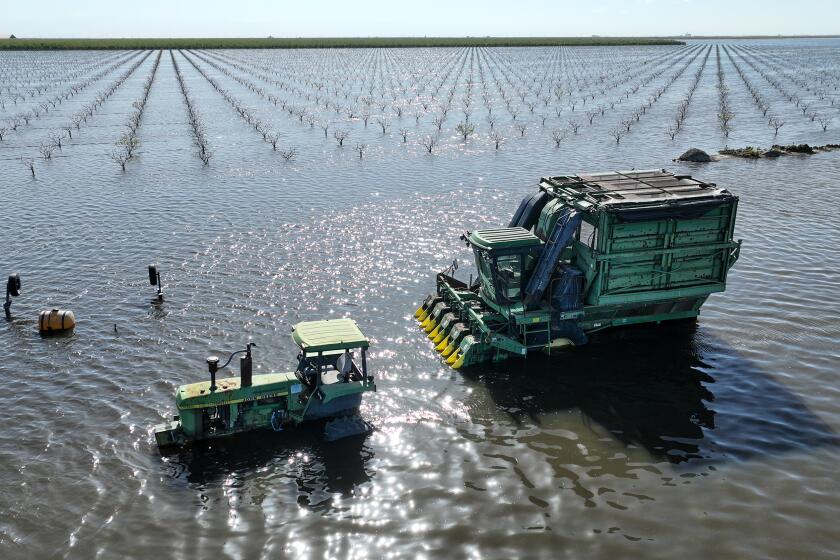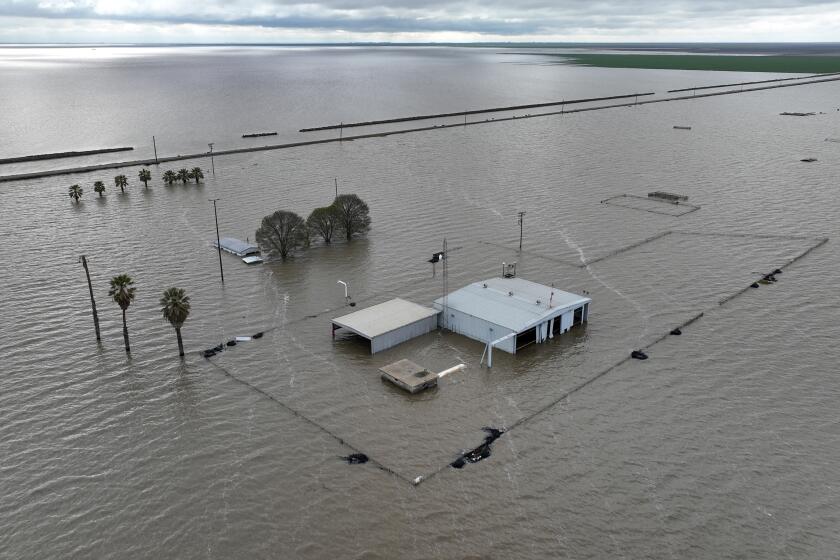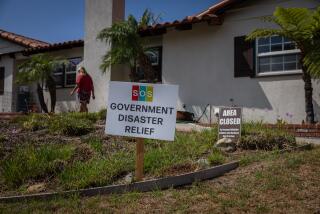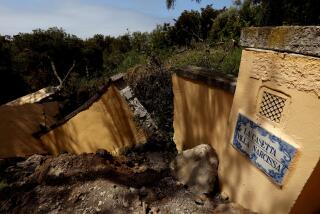California fights to save city, prison in peril from rising Tulare Lake floodwaters
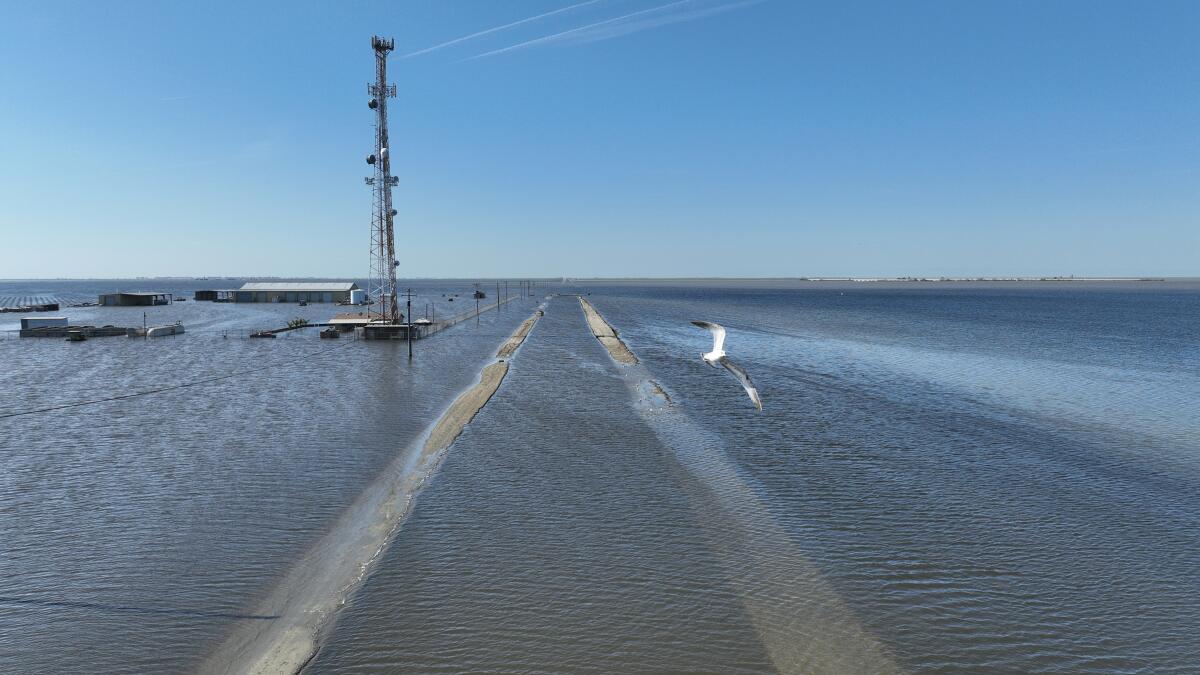
- Share via
Central Valley Californians threatened by this year’s massive Sierra snowmelt will receive much-needed state funding as they rush to raise the Corcoran levee, a critical piece of flood control infrastructure that protects the city of Corcoran and its sprawling prison complex from the rising waters of Tulare Lake.
Local and county officials have for weeks been pleading with the state to help finance the project — a substantial feat of engineering that will involve raising the 14.5-mile earthen embankment about 4 feet to keep floodwaters at bay. The levee is key to protecting critical infrastructure in the area, including medical facilities, power plants and dual prison facilities that hold about 8,000 inmates.
Gov. Gavin Newsom announced the funding Thursday, saying the state will shoulder the $17 million needed to raise the levee from 188 feet above sea level to 192 feet, the historical level needed to protect the community from flooding.
The governor also announced an additional $290 million for flood response and preparation projects.
“California is facing unprecedented weather whiplash — we just experienced the driest three years on record, and now we’re dealing with historic flooding,” Newsom said in a statement. “Our investments must match this reality of climate-driven extremes.”
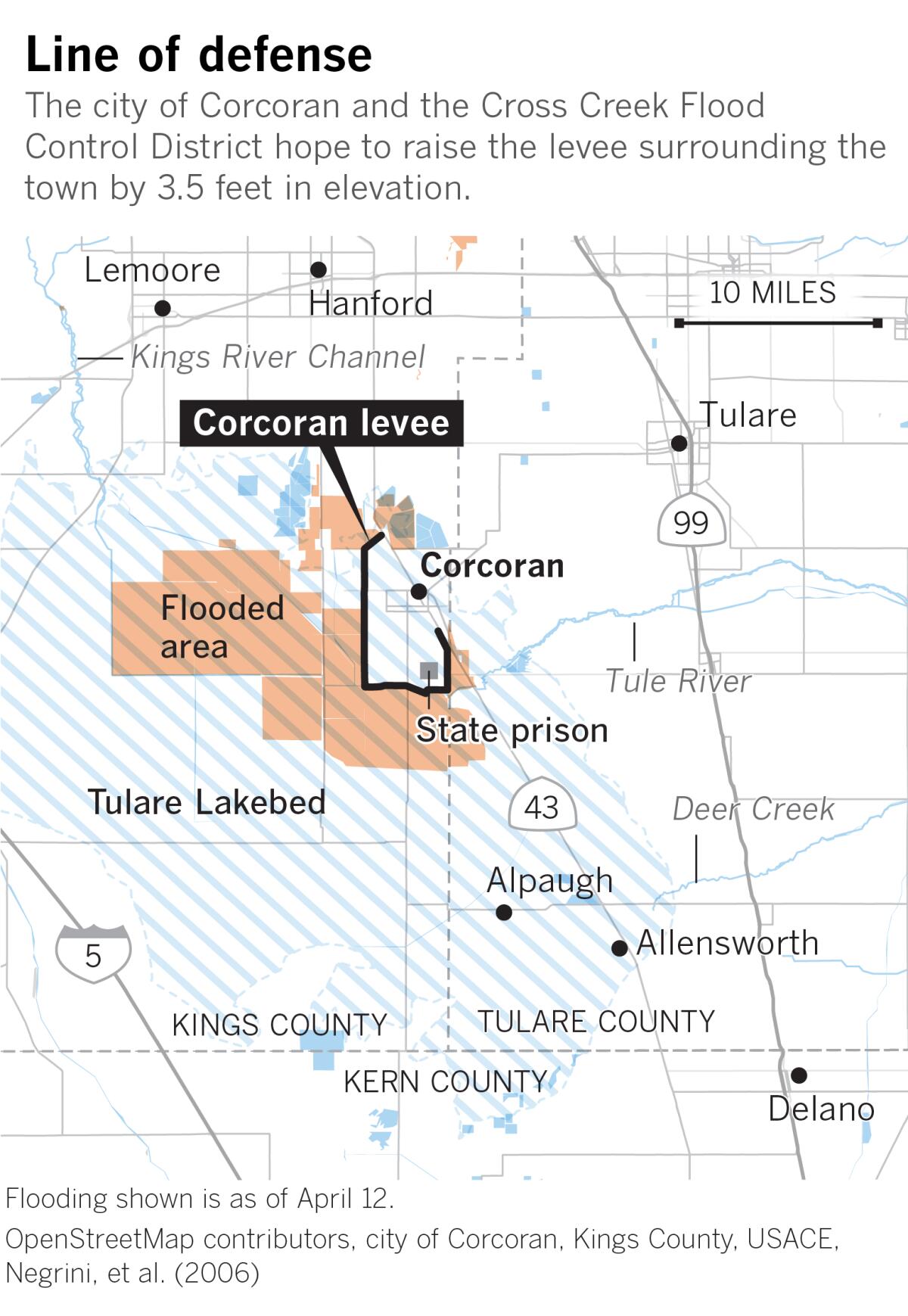
The announcement followed appeals by Corcoran and Kings County officials for help in raising the aging levee. City Manager Greg Gatzka told The Times last month that he was “beyond frustrated” by the difficulty of accessing emergency funding for the repair.
“This is a huge relief,” Gatzka said Thursday. “Knowing that we can fully fund this Corcoran levee reinforcement so that we can protect the whole entire community and two state prisons, from not only the existing flooding that’s already out there — which is about 360,000 acre-feet of water — but the oncoming water that we know is coming from this massive snowmelt.”
The funds will come from the California Disaster Assistance Act and are contingent upon the county completing an update to its hazard mitigation plan, which may enable some costs to be recouped through the Federal Emergency Management Agency, Newsom’s office said.
Also announced Thursday was a revision to the state’s proposed budget that will include an additional $290 million for flood response and preparation projects in the state. The $290 million would come on top of $202 million in flood investments proposed in January. The May budget revision is expected to be released Friday.
The only thing preventing floodwaters from inundating the city of Corcoran is an aging, 14-mile-long wall of dirt. Can it hold?
Among the investments are $125 million for response and recovery from this year’s damaging storms, which will be reallocated from funds originally planned for drought contingency projects, state finance officials said.
Other items include $75 million toward local flood control efforts, including a flood risk management project on the Pajaro River, which experienced its levee breaches and flooding during the storms. The proposed budget also includes $40 million for San Joaquin Floodplain restoration; $25 million to expand current direct assistance programs for agriculture-related businesses that have been affected by recent storms; and $25 million for potential additional disaster relief and response costs to address immediate impacts.
Perhaps nowhere is the work more urgent than in Corcoran, where this year’s wet winter refilled the dry Tulare Lake for the first time in 25 years. Residents there have spent the last several weeks eyeing the snow-capped Sierras with anxiety, with many fearing that the levee is too low to hold back the millions of gallons of runoff that are expected to flow into the basin as its melts.

Indeed, nearly all of the mountains’ record-deep snowpack has yet to melt, with southern Sierra snowpack at 436% of normal for the date as of Thursday, according to state data. The snow water equivalent, or amount of water contained in the snowpack, is 49.9 inches.
Gatzka said the Cross Creek Flood Control District, which is responsible for the levee, has completed about 60% of the repair work and that the state funds will help get the project the rest of the way.
“We’re pretty confident they’re going to finish that before we get too much significant snowmelt coming and adding to Tulare Lake basin,” he said.
Tulare Lake, once the largest freshwater lake west of the Mississippi, was last full in 1878. Recent storms have flooded thousands of acres of farmland in the area.
However, raising the levee may only be a Band-Aid for a larger issue, as Corcoran and much of the Central Valley continues to undergo a process of sinking — also known as subsidence — due to over-pumping of groundwater supplies. The levee has been repaired twice by the U.S. Army Corps of Engineers, in 1969 and 1983.
“Raising the Corcoran levee provides greater certainty that we won’t need to evacuate critical facilities and will ensure public safety,” Newsom said. “However, the state and federal government cannot continue stepping in to raise this levee. I look forward to a conversation on what the local agency is going to do differently so that we don’t find ourselves in this situation again.”
Indeed, much of the larger Tulare Lake region is sinking at a rate of more than a tenth of a foot per year, said Tim Godwin with the Department of Water Resources’ Sustainable Groundwater Management Office. Since 2013, Corcoran has experienced more than 5 feet of subsidence, while areas just outside the town have seen more than 7 feet, he said.
The state in 2014 passed the Sustainable Groundwater Management Act requiring local basins to develop groundwater sustainability plans, but many of the proposals in the Tulare Lake region have not yet been approved, Godwin said. He and other officials said they will be following up with local officials and stakeholders — including the area’s largest landowner, the J.G. Boswell Co. — to ensure that effective groundwater plans are put in place.
“We are hopeful and optimistic that we are taking an emergency protective measure today that’s going to protect a community and its local residents, but also looking forward to the future so that we are not back here in the years to come during a subsequent flood event,” said Brian Ferguson, deputy director of crisis communication for the California Governor’s Office of Emergency Services.
Officials could not provide a firm timeline for the completion of the levee repair, but noted that the work is already underway. With warmer weather on the horizon, there’s little time to waste.
“The work is happening now,” Ferguson said. “I don’t have an end date, but we know that we need to move as quickly as possible.”
Times staff writer Jessica Garrison contributed to this report.
More to Read
Sign up for Essential California
The most important California stories and recommendations in your inbox every morning.
You may occasionally receive promotional content from the Los Angeles Times.
